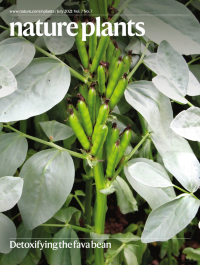- EN - English
- CN - 中文
An Improved System to Measure Leaf Gas Exchange on Adaxial and Abaxial Surfaces
一种改进的测量叶片近轴和远轴表面气体交换的系统
发布: 2023年06月05日第13卷第11期 DOI: 10.21769/BioProtoc.4687 浏览次数: 1392
评审: Ansul LokdarshiRaviraj Mahadeo KalunkeAnonymous reviewer(s)
Abstract
Measurement of leaf carbon gain and water loss (gas exchange) in planta is a standard procedure in plant science research for attempting to understand physiological traits related to water use and photosynthesis. Leaves carry out gas exchange through the upper (adaxial) and lower (abaxial) surfaces at different magnitudes, depending on the stomatal density, stomatal aperture, cuticular permeability, etc., of each surface, which we account for in gas exchange parameters such as stomatal conductance. Most commercial devices measure leaf gas exchange by combining the adaxial and abaxial fluxes and calculating bulk gas exchange parameters, missing details of the plant's physiological response on each side. Additionally, the widely used equations to estimate gas exchange parameters neglect the contribution of small fluxes such as cuticular conductance, adding extra uncertainties to measurements performed in water-stress or low-light conditions. Accounting for the gas exchange fluxes from each side of the leaf allows us to better describe plants' physiological traits under different environmental conditions and account for genetic variability. Here, apparatus and materials are presented for adapting two LI-6800 Portable Photosynthesis Systems to work as one gas exchange system to measure adaxial and abaxial gas exchange simultaneously. The modification includes a template script with the equations to account for small fluxes. Instructions are provided for incorporating the add-on script into the device's computational sequence, display, variables, and spreadsheet results. We explain the method to obtain an equation to estimate boundary layer conductance to water for the new setup and how to embed this equation in the devices' calculations using the provided add-on script. The apparatus, methods, and protocols presented here provide a simple adaptation combining two LI-6800s to obtain an improved system to measure leaf gas exchange on adaxial and abaxial surfaces.
Graphical overview

Figure 1. Diagram of the connection of two LI-6800s. Figure adapted from Márquez et al. (2021).
Background
For simplicity, most common commercial gas exchange devices mix gases from the upper and lower cuvettes to estimate bulk gas exchange parameters from the mix. However, in some cases, it is desirable to analyse the characteristics of the leaf gas exchange on each leaf surface independently, such as when analysing adaxial and abaxial cuticular permeability in planta (Márquez et al., 2022), the stomatal contribution to the gas exchange of each surface (Wall et al., 2022), the estimation of water vapour (Wong et al., 2022) and CO2 (Márquez et al., 2023) gradients within the leaf, etc.
It has been common to use elaborate in-house built gas exchange systems to measure adaxial and abaxial gas exchange independently [see Jarvis and Slatyer (1966), Jones and Slatyer (1972) and Wong et al. (1985)]; however, it requires proficiency in electronics calibration, sensor tuning, environmental conditions control, and expertise in designing the tubing and manifolds. The LI-6800 incorporates automatic calibration protocols, well-tuned sensors, and its design permits modifying the chamber without major interference with the other parts of the system, allowing us to easily conjoin two instruments to analyse the adaxial and abaxial surfaces of a leaf.
The chamber modification demands re-measuring the boundary layer conductance to water for each cuvette to be accounted for in the computation of the gas exchange parameters. In this protocol, we walk the reader through the process of mounting the two LI-6800s together and measuring the boundary layer conductance following a method adapted from Parkinson (1985) to be used in LI-6800 devices. We provide an add-on script for the LI-6800 to include the new boundary layer conductance estimations for each cuvette in the calculations. The add-on script also includes an update to the latest theory for estimating gas exchange parameters presented by Márquez et al. (2021), which is a more precise physical approach to the electrical resistance analogy for gas exchange. The new boundary layer conductance and equations are included in the instrument's computation, display, variables, and spreadsheet results using the add-on code.
Materials and reagents
Joining two LI-6800
Two cuvette flanges (in-house designed, schematics in Supplement 1)
Lower chamber lid (in-house designed, schematics in Supplement 2)
Sealed top chamber lid (in-house designed)
Note: Sealed top lid design is similar to the lower chamber lid design except for the thermocouple holder apertures. The sealed top chamber lid does not have thermocouple holder apertures.
Sealed flange (in-house designed, schematics in Supplement 3)
Flexible stainless-steel tube, 12 mm diameter
O-rings and screws according to the schematics
Thermocouple extension cable with 3.5 mm Jack connectors
(Recommended) LI-6800 Custom Chambers Manifold (LI-COR, catalog number: 6800-19)
Bev-A-line IV tube
Before taking measurements
Polycarbonate sheet 2–3 mm thick, big enough to cover the surface of the chamber and seals
Boundary layer conductance estimation
Glass microfibre filters GF/A 9 cm (Whatman, catalog number: WHA1820090)
PEEK tube Orange 1/16 × 0.02 (IDEX, catalog number: 1532)
250 mL glass beaker
Pure water (reverse osmosis or distilled)
Equipment
Two photosynthesis systems LI-6800 (LI-COR Biosciences, Lincoln, Nebraska)
Software
Add-on script for LI-6800 to use double chamber (in-house coded, download from: https://github.com/PlantPhysiologist/MSF_UpperLower)
Procedure
文章信息
版权信息
© 2023 The Author(s); This is an open access article under the CC BY-NC license (https://creativecommons.org/licenses/by-nc/4.0/).
如何引用
Márquez, D. A., Stuart-Williams, H., Wong, S. C. and Farquhar, G. D. (2023). An Improved System to Measure Leaf Gas Exchange on Adaxial and Abaxial Surfaces. Bio-protocol 13(11): e4687. DOI: 10.21769/BioProtoc.4687.
分类
植物科学 > 植物生理学
您对这篇实验方法有问题吗?
在此处发布您的问题,我们将邀请本文作者来回答。同时,我们会将您的问题发布到Bio-protocol Exchange,以便寻求社区成员的帮助。
Share
Bluesky
X
Copy link










